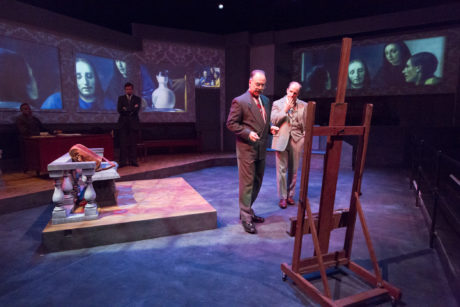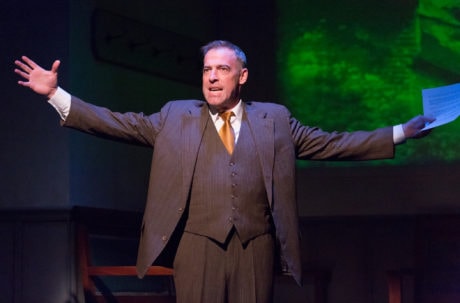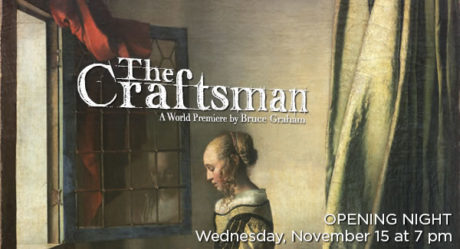Guilty or not guilty? And of what crime? An intriguing real-life episode from 20th-century Art History provides the basis for The Craftsman, Bruce Graham’s latest world-premiere play commissioned and presented by Lantern Theater Company as part of its New Works Initiative. Directed by M. Craig Getting and featuring a dream cast of Philadelphia all-stars, the fictionalized account of the infamous case of artist and art dealer Han van Meegeren – accused of selling newly-discovered “national treasures” by 17th-century Dutch master Jan Vermeer to the Nazis – is a richly-layered examination of truth and deception, human motivation and widespread gullibility, seen in the context of The Netherlands’ fervent commitment to the Nazi Resistance in the aftermath of World War II.

Structurally, Graham’s compelling narrative moves back and forth in time, fleshing out the backstories of the key players, the socio-political climate of the Allied nation in and around Amsterdam 1946-47 (following the defeat of the Axis powers), and the seemingly irrefutable evidence presented in the courtroom drama. Flashbacks of personal relationships, encounters, and confrontations – with the recollection of one key scene in the artist’s atelier realistically changing ever-so-slightly with each retelling, as the details of our recounted memories so often do – are interspersed throughout the scenes of van Meegeren’s arrest and trial for the treasonous act of “collaborating with the enemy.”
Getting’s finely-calibrated direction maintains all of the inherent tension and suspense of the story, and captures all of Graham’s signature sardonic wit and irony, up to the astonishing stranger-than-fiction climax that would upend the government’s case, its ‘expert’ witnesses, and the tide of public opinion. He moves the actors seamlessly around the multilevel set (smart and efficient scenic design by Meghan Jones), from the office of the post-war provisional government to the detention room where van Meegeren was held and the court where he was tried, to re-enactments of past events in his studio and outside (signaled by shifts in Shannon Zura’s focused lighting). Every moment is clear and illuminating, and the steady unfolding of each revelation of the plot and character development keeps us on the edge of our seats.
Graham’s ingenious script is brought to life by a stellar six-person ensemble that is cast to perfection, all fully inhabiting the characters and manifesting the flaws that make them consummately human – their egos and insecurities, their self-serving lies and flattery, their feelings of hatred and vengeance engendered by the pain they suffered in their lives and the atrocities they experienced first-hand during the Nazi Occupation. Longtime Lantern favorite Anthony Lawton stars as the crafty van Meegeren, a trained architect and popular self-taught portraitist who established his fame and fortune, and attained the validation and immortality he craved, not as an artist, but as a con man. He is defiant and disheartened, whimpering and laughing, mocking and pleading, determined to prove his talent and delighted to dupe, and then to humiliate, the “esteemed critic” who belittled him as a mere “craftsman.”

The ever-masterful Ian Merrill Peakes, making his highly-anticipated Lantern debut, co-stars as the artist’s nemesis Captain Joseph Pillel, active soldier during the war, interim leader of the government, and ardent anti-Nazi enforcer who will stop at nothing to hold van Meegeren accountable for his alleged sale of Vermeer paintings to Hermann Göring, the second-highest-ranking official in Hitler’s Third Reich. The evolution of his character is impeccable, as he transforms from a nervous public figure addressing the crowd for the first time to an “avenging angel” resolute on punishing anyone and everyone suspected of collusion with the Nazis – at whose hands he, his nation, and his people suffered immeasurably – to an increasingly gentle and self-reflecting man who comes to regret the rage that has driven him since the war (with “hatred getting in the way of common sense”).
Giving outstanding support to the leads, Dan Hodge portrays the ambitious Prosecutor Boll with just right balance of humor, sensitivity, and strict adherence to the letter of the law, and Paul L. Nolan is laughably imperious as the revered Art Historian Dr. Abraham Bredius, a respected authority on Vermeer, and the “pompous ass” who callously dismisses van Meegeren’s work, while willfully fighting the attacks made against him and his own private life. Rounding out the terrific cast are Mary Lee Bednarek as van Meegeren’s beautiful and forceful second wife Johanna, who demands answers from Pillel, is accepting of her husband’s well-known “debauchery,” and may know more than she’s letting on about the case against him; and Brian McCann, who skillfully distinguishes his three roles as the guard Augustun (who, like Pillel, begins to soften towards his prisoner), the outspoken art conservator Rotke (who gives the artist his uncensored view of the Vermeer painting in question), and the no-nonsense Judge (who presides over van Meegeren’s trial).
The play’s 1940s Dutch setting is enhanced by Kayla Speedy’s period-style costumes (with traditional suits and uniforms for the men and fineries for the wealthy Johanna); by Christopher Colucci’s transportive sound design (including the noise of the angry crowd outside van Meegeren’s cell and the explosions and gunfire of the war); and by Janelle Kauffman’s integral projections (of masterpieces by Vermeer and details of gabled houses from his cityscapes; the paintings sold by van Meegeren; and wartime images of The Netherlands).
With The Craftsman, Bruce Graham proves once again that he is a master at observing the human condition and understanding the deep-seated emotions that drive us. And the Lantern’s world-class production proves once again that this is the thinking person’s go-to theater company, delivering Graham’s insightful vision with a superb cast, director, and design team. In the words spoken by Dr. Bredius, “Great art evokes a response . . . emotion.” The Craftsman does, and is.

Running Time: Approximately two hours and ten minutes, including an intermission.
The Craftsman plays through Sunday, December 17, 2017, at Lantern Theater Company, performing at St. Stephen’s Theater – 923 Ludlow Street, Philadelphia, PA. For tickets, call (215) 829-0395, or purchase them online.





One hellova review, Deb! Included ALL of the folks who make a production soar. Cant wait for my ticket time!!!
Thank you for the wonderful review.
Great news: we’re extending! THE CRAFTSMAN will now close on Sunday, December 17. http://www.lanterntheater.org